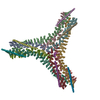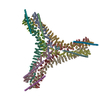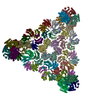[English] 日本語
 Yorodumi
Yorodumi- PDB-6sct: Cryo-EM structure of the consensus triskelion hub of the clathrin... -
+ Open data
Open data
- Basic information
Basic information
| Entry | Database: PDB / ID: 6sct | ||||||||||||
|---|---|---|---|---|---|---|---|---|---|---|---|---|---|
| Title | Cryo-EM structure of the consensus triskelion hub of the clathrin coat complex | ||||||||||||
 Components Components |
| ||||||||||||
 Keywords Keywords | TRANSPORT PROTEIN / clathrin / coat protein / endocytosis / trafficking | ||||||||||||
| Function / homology |  Function and homology information Function and homology informationclathrin coat of trans-Golgi network vesicle / clathrin light chain binding / clathrin complex / clathrin coat of coated pit / clathrin coat assembly / clathrin-coated endocytic vesicle / clathrin-coated vesicle / receptor-mediated endocytosis / ribosomal large subunit biogenesis / intracellular protein transport ...clathrin coat of trans-Golgi network vesicle / clathrin light chain binding / clathrin complex / clathrin coat of coated pit / clathrin coat assembly / clathrin-coated endocytic vesicle / clathrin-coated vesicle / receptor-mediated endocytosis / ribosomal large subunit biogenesis / intracellular protein transport / spindle / disordered domain specific binding / mitotic cell cycle / nucleolus / structural molecule activity / extracellular exosome / nucleoplasm / cytosol Similarity search - Function | ||||||||||||
| Biological species |  | ||||||||||||
| Method | ELECTRON MICROSCOPY / single particle reconstruction / cryo EM / Resolution: 4.69 Å | ||||||||||||
 Authors Authors | Morris, K.L. / Cameron, A.D. / Sessions, R. / Smith, C.J. | ||||||||||||
| Funding support |  United Kingdom, 3items United Kingdom, 3items
| ||||||||||||
 Citation Citation |  Journal: Nat Struct Mol Biol / Year: 2019 Journal: Nat Struct Mol Biol / Year: 2019Title: Cryo-EM of multiple cage architectures reveals a universal mode of clathrin self-assembly. Authors: Kyle L Morris / Joseph R Jones / Mary Halebian / Shenping Wu / Michael Baker / Jean-Paul Armache / Amaurys Avila Ibarra / Richard B Sessions / Alexander D Cameron / Yifan Cheng / Corinne J Smith /   Abstract: Clathrin forms diverse lattice and cage structures that change size and shape rapidly in response to the needs of eukaryotic cells during clathrin-mediated endocytosis and intracellular trafficking. ...Clathrin forms diverse lattice and cage structures that change size and shape rapidly in response to the needs of eukaryotic cells during clathrin-mediated endocytosis and intracellular trafficking. We present the cryo-EM structure and molecular model of assembled porcine clathrin, providing insights into interactions that stabilize key elements of the clathrin lattice, namely, between adjacent heavy chains, at the light chain-heavy chain interface and within the trimerization domain. Furthermore, we report cryo-EM maps for five different clathrin cage architectures. Fitting structural models to three of these maps shows that their assembly requires only a limited range of triskelion leg conformations, yet inherent flexibility is required to maintain contacts. Analysis of the protein-protein interfaces shows remarkable conservation of contact sites despite architectural variation. These data reveal a universal mode of clathrin assembly that allows variable cage architecture and adaptation of coated vesicle size and shape during clathrin-mediated vesicular trafficking or endocytosis. | ||||||||||||
| History |
|
- Structure visualization
Structure visualization
| Movie |
 Movie viewer Movie viewer |
|---|---|
| Structure viewer | Molecule:  Molmil Molmil Jmol/JSmol Jmol/JSmol |
- Downloads & links
Downloads & links
- Download
Download
| PDBx/mmCIF format |  6sct.cif.gz 6sct.cif.gz | 1 MB | Display |  PDBx/mmCIF format PDBx/mmCIF format |
|---|---|---|---|---|
| PDB format |  pdb6sct.ent.gz pdb6sct.ent.gz | 762.3 KB | Display |  PDB format PDB format |
| PDBx/mmJSON format |  6sct.json.gz 6sct.json.gz | Tree view |  PDBx/mmJSON format PDBx/mmJSON format | |
| Others |  Other downloads Other downloads |
-Validation report
| Summary document |  6sct_validation.pdf.gz 6sct_validation.pdf.gz | 1 MB | Display |  wwPDB validaton report wwPDB validaton report |
|---|---|---|---|---|
| Full document |  6sct_full_validation.pdf.gz 6sct_full_validation.pdf.gz | 1.1 MB | Display | |
| Data in XML |  6sct_validation.xml.gz 6sct_validation.xml.gz | 127.2 KB | Display | |
| Data in CIF |  6sct_validation.cif.gz 6sct_validation.cif.gz | 195.1 KB | Display | |
| Arichive directory |  https://data.pdbj.org/pub/pdb/validation_reports/sc/6sct https://data.pdbj.org/pub/pdb/validation_reports/sc/6sct ftp://data.pdbj.org/pub/pdb/validation_reports/sc/6sct ftp://data.pdbj.org/pub/pdb/validation_reports/sc/6sct | HTTPS FTP |
-Related structure data
| Related structure data |  0126MC  0114C  0115C  0116C  0118C  0120C  0121C  0122C  0123C  0124C  0125C M: map data used to model this data C: citing same article ( |
|---|---|
| Similar structure data | |
| EM raw data |  EMPIAR-10296 (Title: Single particle cryo-EM dataset of the triskelion hub subparticle extraction from clathrin cages EMPIAR-10296 (Title: Single particle cryo-EM dataset of the triskelion hub subparticle extraction from clathrin cagesData size: 88.4 Data #1: Hub subparticles of the 28 mini coat [picked particles - multiframe - unprocessed] Data #2: Hub subparticles of the 32 sweet potato [picked particles - multiframe - unprocessed] Data #3: Hub subparticles of the 36 D6 barrel [picked particles - multiframe - unprocessed] Data #4: Hub subparticles of the 36 tennis ball [picked particles - multiframe - unprocessed] Data #5: Hub subparticles of the 37 big apple [picked particles - multiframe - unprocessed]) |
- Links
Links
- Assembly
Assembly
| Deposited unit | 
|
|---|---|
| 1 |
|
- Components
Components
| #1: Antibody | Mass: 191826.344 Da / Num. of mol.: 9 Source method: isolated from a genetically manipulated source Source: (gene. exp.)   #2: Protein | Mass: 25218.500 Da / Num. of mol.: 6 Source method: isolated from a genetically manipulated source Source: (gene. exp.)   |
|---|
-Experimental details
-Experiment
| Experiment | Method: ELECTRON MICROSCOPY |
|---|---|
| EM experiment | Aggregation state: PARTICLE / 3D reconstruction method: single particle reconstruction |
- Sample preparation
Sample preparation
| Component | Name: clathrin cage triskelion hub consensus structure consisting of heavy and light chains Type: COMPLEX / Entity ID: all / Source: RECOMBINANT |
|---|---|
| Molecular weight | Value: 0.54 MDa / Experimental value: NO |
| Source (natural) | Organism:  |
| Source (recombinant) | Organism:  |
| Buffer solution | pH: 6.4 |
| Specimen | Embedding applied: NO / Shadowing applied: NO / Staining applied: NO / Vitrification applied: YES |
| Specimen support | Grid material: COPPER / Grid mesh size: 300 divisions/in. / Grid type: Quantifoil R1.2/1.3 |
| Vitrification | Instrument: HOMEMADE PLUNGER / Cryogen name: ETHANE-PROPANE / Details: Ambient temperature and humidity |
- Electron microscopy imaging
Electron microscopy imaging
| Experimental equipment |  Model: Titan Krios / Image courtesy: FEI Company |
|---|---|
| Microscopy | Model: FEI TITAN KRIOS |
| Electron gun | Electron source:  FIELD EMISSION GUN / Accelerating voltage: 300 kV / Illumination mode: FLOOD BEAM FIELD EMISSION GUN / Accelerating voltage: 300 kV / Illumination mode: FLOOD BEAM |
| Electron lens | Mode: BRIGHT FIELD / Nominal magnification: 82111 X / Nominal defocus max: 2800 nm / Nominal defocus min: 1800 nm / Cs: 2.7 mm / Alignment procedure: COMA FREE |
| Specimen holder | Cryogen: NITROGEN / Specimen holder model: FEI TITAN KRIOS AUTOGRID HOLDER |
| Image recording | Electron dose: 69 e/Å2 / Detector mode: INTEGRATING / Film or detector model: FEI FALCON II (4k x 4k) |
| Image scans | Sampling size: 14 µm / Width: 4096 / Height: 4096 |
- Processing
Processing
| Software | Name: PHENIX / Version: 1.14_3260: / Classification: refinement | ||||||||||||||||||||||||
|---|---|---|---|---|---|---|---|---|---|---|---|---|---|---|---|---|---|---|---|---|---|---|---|---|---|
| EM software |
| ||||||||||||||||||||||||
| CTF correction | Type: PHASE FLIPPING AND AMPLITUDE CORRECTION | ||||||||||||||||||||||||
| Particle selection | Num. of particles selected: 12785 / Details: Manual picking | ||||||||||||||||||||||||
| Symmetry | Point symmetry: C3 (3 fold cyclic) | ||||||||||||||||||||||||
| 3D reconstruction | Resolution: 4.69 Å / Resolution method: FSC 0.143 CUT-OFF / Num. of particles: 313406 / Algorithm: BACK PROJECTION / Num. of class averages: 1 / Symmetry type: POINT | ||||||||||||||||||||||||
| Atomic model building | Protocol: FLEXIBLE FIT / Target criteria: Cross-correlation coefficient | ||||||||||||||||||||||||
| Refine LS restraints |
|
 Movie
Movie Controller
Controller




 PDBj
PDBj


